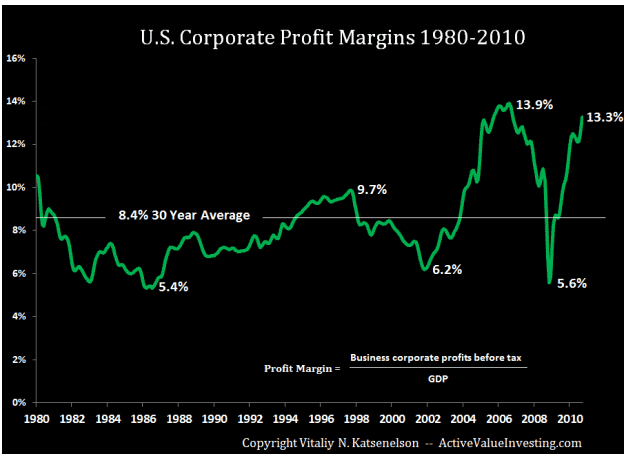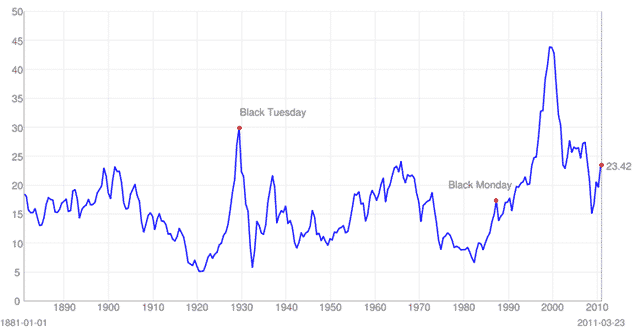Stocks are not cheap
If you look at U.S. equity valuations based on value metrics like the Shiller P/E, stocks are rather expensive right now. The logic goes like this:
- Many factors within an individual business cycle are mean-reverting.
- In order to capture the mean reversion effect, one needs to take stock earnings and price data from a number of consecutive years instead of just one.
- While fundamental changes in the operating environment or core strategy of an individual firm could override this mean reversion effect (poor economics make an expensive stock look cheap or a profitable new market makes a good stock look expensive, etc.), the mean reversion effect is always in effect for the market as a whole.
- Therefore, to the degree one wants to conduct meaningful asset allocation, one must capture the mean reversion effect for the overall market.
Vitaliy Katsenelson has done this analysis and found the near record and mean-reverting profit margins for U.S. firms make U.S. equities overvalued. At Forbes, he writes:
Profit margins are a tick away from all-time highs and are creating the impression of cheap equity valuations. That impression is a mirage, however, because today’s generous margins are destined to shrink.
I first wrote about this in January 2008, and this is an update to that article. All I had to do was to update a chart and the numbers in the article and add a few comments – all of them are underlined.
Stocks are allegedly cheap now, at 15.7 times 2010 earnings. And they are cheap by historical standards. Only 10 years ago, their price/earnings ratios were double today’s; they are even cheaper if you compare their forward (2011) earnings yield of 7.3% to the 10-year Treasury yield of3.40%. They are cheap, cheap, cheap!
Or so we’ve been told.
Unfortunately, the cheapness argument falls on its face once we realize that pretax profit margins are hovering close to an all-time high of 13.3% (the all-time high was 13.9% in 2007), almost 58% above their average of8.4% since 1980.
And he presents the perfect chart to prove what he is saying.
Katsenelson says:
Once profit margins revert to their historical mean, the “E” in the P/E equation will decline. If the market made no price change in response, its P/E would rise from 15.7 to 24.9 times trailing earnings.
That’s way expensive. What’s more, you can replicate this any number of ways using value metrics. If you use the Shiller P/E, known as the cyclically-adjusted price earnings ratio (CAPE), you get a very similar number for the present P/E, 23.4 times trailing earnings. That is historically very high as this chart demonstrates (source: https://www.multpl.com/).
Of course, the profit mean reversion does not have to happen immediately. Katsenelson does a good job of picking through a number of arguments why it could be delayed. He also does a good job of debunking these theories. I would say this: right now, commodity prices are high and adding to producer price inflation. As yet, these cost increases have not entirely passed through to consumers. This will eventually be a drag on profit margins if the costs cannot be passed through. I would argue that companies have been able to keep margins high despite this cost increase because they have not added significant head count during this statistical recovery. However, given the lack of jobs and the impact those same increases in commodity prices are having on consumers, this leaves the U.S. economy – and continued robust earnings growth – dependent either on increased consumption by high-income/wealth households or on the accumulation of debt (see last week’s post Chart of the Day: U.S. Real Wages). Unless hiring picks up substantially, earnings growth will mean revert quickly.
Making this situation more critical is the likelihood of continued price pressure in the commodities space. Just yesterday, Robert Shiller wrote an article at Project Syndicate called "Bubble Spotting". In it, he worried that the commodity-price boom had a "new era" story around it that would trigger even higher prices. If this is true, there will be even more cost pressure on companies that cannot be passed through, and that means margins will erode.
Value investors like Jeremy Grantham are worried. Despite our being in the favourable third-year of a presidential cycle, Grantham has started to ratchet back his enthusiasm. He has said he could see the S&P500 going up to 1500, yes. But, “what people will find, and what they might have underestimated, are the tentacles that Japan Inc. sends out around the world,”
“It’s an overpriced global equity world,” Grantham said. “There aren’t that many opportunities, and there are some pretty scary things out there, so it’s a good time to be careful.”
When the Fed stops its quantitative easing program in June, we will see what kind of legs the economy and stock market really have.


Comments are closed.